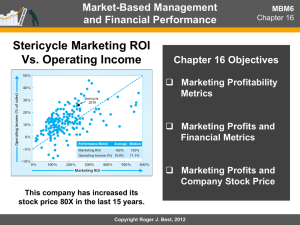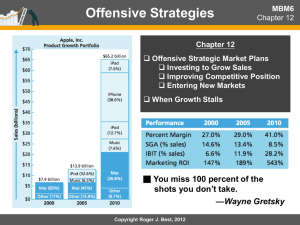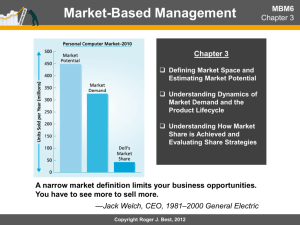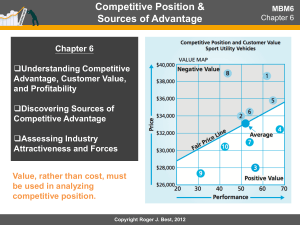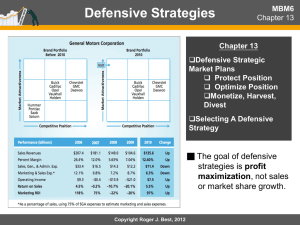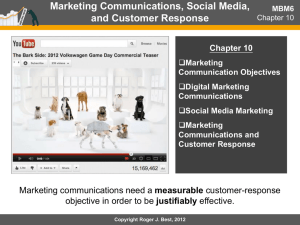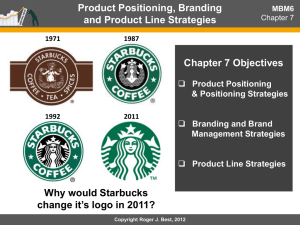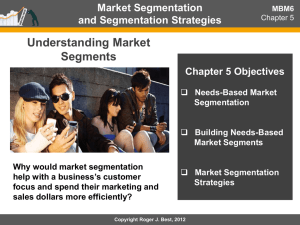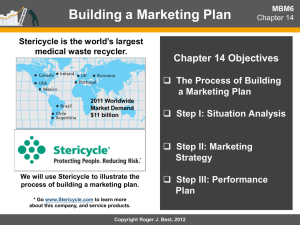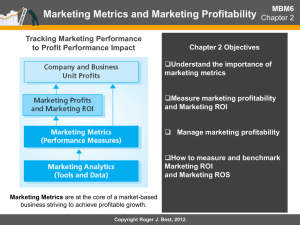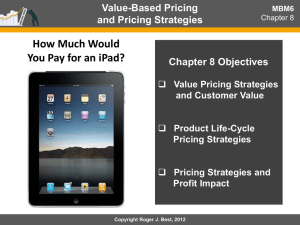Customers
advertisement
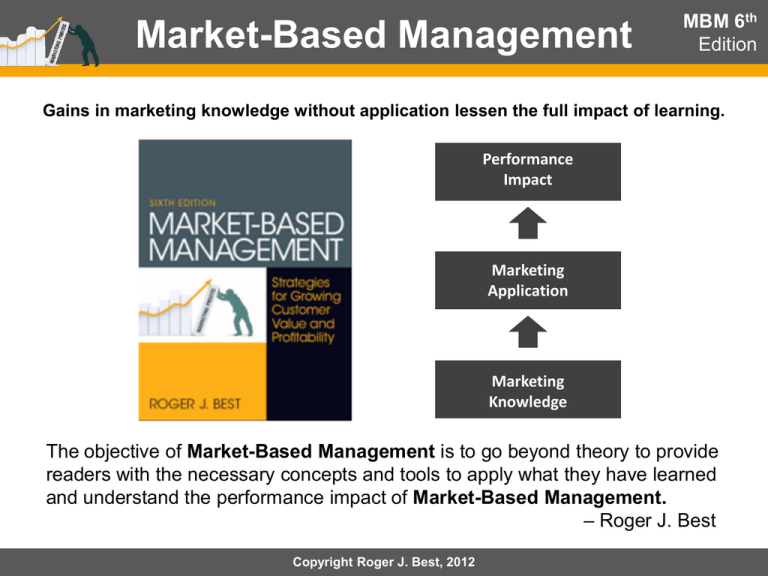
Market-Based Management MBM 6th Edition Gains in marketing knowledge without application lessen the full impact of learning. Performance Impact Marketing Application Marketing Knowledge The objective of Market-Based Management is to go beyond theory to provide readers with the necessary concepts and tools to apply what they have learned and understand the performance impact of Market-Based Management. – Roger J. Best Copyright Roger J. Best, 2012 Customer Focus, Customer Performance, and Profit Impact MBM6 Chapter 1 Very Satisfied Customers Drive Profits Chapter 1 Objectives Building a customer focused organization Measuring customer performance Profit impact of customer retention and customer loyalty. Satisfied is not good enough. Completely satisfied—that’s a big deal. A completely satisfied customer is at least three times more likely to return than one who’s just satisfied. ―Andrew Taylor, CEO, Enterprise Rent-A-Car Copyright Roger J. Best, 2012 Customer Focus, Customer Performance, and Profit Impact MBM6 Chapter 1 Building a CustomerFocused Organization In this section we will look at how customer-focused organizations not only outperform their competition over the long term by consistently delivering higher levels of customer satisfaction, they also realize higher profits over the short run. Copyright Roger J. Best, 2012 Underwhelming Customers MBM6 Chapter 1 Little or no customer focus translates into an unfocused competitive position and minimal customer satisfaction. The result is a vicious (墮落的)circle of poor performance. Copyright Roger J. Best, 2012 Top Performers Produce Higher Investor Returns MBM6 Chapter 1 Apple, Southwest Airlines, and Clorox would be a part of the top performers in the graph above. Their average stock price index started at 100 and 10 years later was 300. Poor performers started at 100 and 10 years later were still at 100. Copyright Roger J. Best, 2012 Customer-Focused Organization MBM6 Chapter 1 • Senior Mgmt Leadership •Employee Customer Training • Customer Involvement • Customer Experiences • Customer Solutions • Customer Complaints • Customer Satisfaction • Customer Retention • Customer Loyalty How would this model work differently in Bank of America vs. Southwest Airlines? Copyright Roger J. Best, 2012 Benchmarking Customer Satisfaction MBM6 Chapter 1 American Customer Satisfaction Index - University of Michigan (www.theACSI.org) ACSI studies have shown that Customer Satisfaction is a leading indicator of company financial performance. The ACSI database reports all companies by industry. Copyright Roger J. Best, 2012 Customer Focus, Customer Performance, and Profit Impact MBM6 Chapter 1 Measuring Customer Performance In this section we will look at how companies that use customer performance metrics are able to identify their unprofitable customers. For any business, knowing which customers not to attract is just as important as knowing which customers to attract. Copyright Roger J. Best, 2012 Customer Satisfaction A Key Performance Metric MBM6 Chapter 1 Very Satisfied 100 Satisfied 80 Somewhat Satisfied 60 Somewhat Dissatisfied 40 Dissatisfied 20 Very Dissatisfied 0 To determine the CSI for a sampling of customers, simply compute the average of the customers’ satisfaction ratings. Customer satisfaction is a forecast of future revenues and profits. Copyright Roger J. Best, 2012 Customer Satisfaction – Wide-Angle View MBM6 Chapter 1 De-averaging CSI provides a wide-angle view of customer satisfaction and allows managers to see more completely the opportunities for improvement. (de- 離開、低下) Copyright Roger J. Best, 2012 Profit Impact of Very Satisfied Customers Marketing Performance Tool 1.1 De-averaging CSI is critical to understanding customer profitability “Very satisfied” customers not only buy more, they often buy higher-margin products and services, which results in a higher percent margin on total sales. Copyright Roger J. Best, 2012 Profitability of Satisfied Customers MBM6 Chapter 1 When we chart customer profitability against customer satisfaction, we see that the “very satisfied” customers are the ones who drive profitability. Copyright Roger J. Best, 2012 Complaint Behavior and Retention Marketing Performance Tool 1.2 Dissatisfied customers often do not complain, but they do walk and they do talk. Each year, the business above loses $22,400 customers who are dissatisfied, but do not complain. Copyright Roger J. Best, 2012 Customer Dissatisfaction and the Use of Social Media MBM6 Chapter 1 Facebook as an Outlet for Customer Dissatisfaction An individual’s car was towed despite being legally parked with a valid parking sticker. The individual created a Facebook page to express his dissatisfaction with the towing company. More than 10,000 supporters, some using other social media, also expressed their dissatisfaction with the towing company. Many related their own bad experiences, and 20 formal complaints were filed over a 3-year period as a result . Copyright Roger J. Best, 2012 Managing the Customer Experience with Twitter MBM6 Chapter 1 Alaska Air uses twitter as a channel to promote new fares/routes and to field customer service issues. Their twitter page is a mix of responses to customers, promotions, and warnings of weather delays. Copyright Roger J. Best, 2012 Estimating Customer Retention MBM6 Chapter 1 How likely are you to buy this product or brand again on your next purchase? To estimate retention rates, businesses can use a customer survey as outlined above. Copyright Roger J. Best, 2012 NetFlix Customer Retention MBM6 Chapter 1 The Customer Lifetime Value increases exponentially with increases in Customer Retention. How will the radical price increase of 60% in 2011 impact NetFlix’s customer retention? Copyright Roger J. Best, 2012 Customer Performance and Profit Impact MBM6 Chapter 1 Profit impact of customer retention and customer loyalty. In this section we will look at how loyal customers have a longer customer history, are more committed to the company brand, buy more, and are more likely to recommend the brand to others. Copyright Roger J. Best, 2012 Assessing Customer Loyalty MBM6 Chapter 1 Loyal customers have a long customer history, buy at an above-average purchase amount, have a high desire to repurchase, have strong product preferences for the company’s products and would recommend the company’s products to friends, relatives, and co-workers. Copyright Roger J. Best, 2012 Managing Customer Loyalty MBM6 Chapter 1 Loyal Customers – High performance in all five aspects of customer loyalty Repeat Customers – Great customers that buy often but score lower on purchase amount, product preference, and customer recommendation. Captive(俘虜)Customers – Have a long customer history and average purchase amount but would leave if they could, as they are dissatisfied captive customers. New Customers – Score low on all aspects of customer loyalty as they do not yet have the customer history to assess their customer loyalty. Unprofitable Customers – Score low on all aspects of customer loyalty. Copyright Roger J. Best, 2012 Customer Retention and Profitability MBM6 Chapter 1 Placing a high priority on satisfying and retaining customers can provide tremendous financial leverage. Every additional customer who is retained increases a business’s net profit. Copyright Roger J. Best, 2012 Customer Lifetime Value Marketing Performance Tool 1.3 The average credit card customer for this company has a customer life of 5 years. It costs the company $51 to acquire a new customer and by year 5 they produce $55 in customer profit. The lifetime value using a 10% discount rate is $111.70, the net present value of the customer cash flow over 5 years. Copyright Roger J. Best, 2012 Customer Lifetime Value and Customer Loyalty MBM6 Chapter 1 Customer Loyalty Scores and Customer Lifetime Value are closely correlated. Copyright Roger J. Best, 2012 Value of Online Customers MBM6 Chapter 1 The cost of acquiring an online grocery customer is almost twice the cost of acquiring an online consumer electronics or apparel customer. Copyright Roger J. Best, 2012 Customer Lifetime Value Of Win-Back Customers MBM6 Chapter 1 The return of a former customer is a lost opportunity that has reappeared— a second chance to develop a loyal customer. The “second lifetime value” of a win-back customer has a net present value almost 3x higher than the average lifetime value of an entirely new customer. Copyright Roger J. Best, 2012 Customer Loyalty & Customer Profitability Marketing MBM6 Performance Chapter Tool 1.4 1 Loyal customers play an important role in company profitability. How would management of customer loyalty improve profits? Copyright Roger J. Best, 2012
